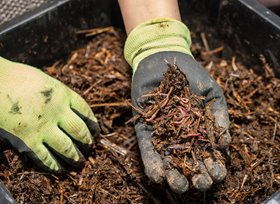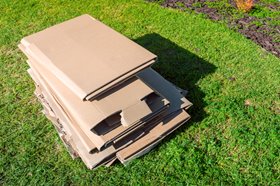No dig gardening is a method often favoured by organic growers and it has quickly become one of the biggest gardening trends in recent years. While it may be a new concept to many people, it has been mentioned in garden literature for decades. But what exactly is no dig gardening and how can it benefit your garden?
What is no dig gardening?

No dig gardening is a method of cultivation that aims to leave the soil undisturbed – creating and maintaining growing areas without digging the soil. Instead, organic matter, such as garden compost or well-rotted manure, is layered on top of the existing soil surface, mimicking the natural processes of decomposition of plants.
In addition to not disturbing the soil structure, worms and other organisms are not disturbed, therefore allowing the natural soil ecosystem to thrive.
As a growing method, no dig gardening feeds your soil, helps control weeds, and saves your time and back in the process!
So, whether you have a small allotment plot or a large garden, if you’d like to put down your spade and avoid hours spent digging over beds, read on to find out why no dig gardening could be beneficial for you.
What are the benefits of no dig gardening?
There are several reasons why no dig gardening appeals to organic gardeners – we’ve listed some of the benefits below:
Less Watering
Mulching soil (adding a layer of organic matter on top of the soil surface) helps to retain moisture, meaning you need to water less. The no dig method can also help to improve drainage as by not digging you avoid soil compaction which occurs when the soil is compacted into a solid, impermeable layer, restricting water and nutrients moving through the soil.
Less Weeding
By not digging you avoid disturbing weed seeds and roots, stopping them from being brought to the surface, germinating and growing. Adding a layer of organic matter, such as garden compost or well-rotted manure, to the top of the soil surface acts as a weed-suppressing mulch, making it harder for weeds to get through.
Bigger Harvests
There is evidence to suggest that no dig beds can produce bigger veg harvests than traditional beds that are dug over.
Warmer Soil
The temperature of undug soil is higher than soil that has been dug over which can be particularly valuable for crops being grown in colder climates and during colder times of year.
Soil Carbon
Soil holds a lot of carbon dioxide which is released into the air when we dig the soil. By not digging, you can ensure the carbon stays below the surface.
 Thriving Soil Ecosystem
Thriving Soil Ecosystem
As mentioned earlier, by not digging and disturbing the soil structure, you allow the natural soil ecosystem to thrive. Mulching soil with garden compost mimics the natural processes of decomposition of plants and allows worms and other organisms living in the soil to eat the organic matter you have layered onto the surface and excrete it into the soil.
Save Time
Adopting the no dig gardening method means you can spend less time digging, weeding and watering. No dig gardening is also great for gardeners who are unable to or want to avoid a lot of digging which can be very physically demanding.
How to start a no dig garden

If you would like to start a no dig garden, the great news is that you don’t need lots of things to get started – you will need a patch of ground, some cardboard and plenty of compost.
Once you have decided on the area for your new no dig bed, you will need to prepare the site by blocking out the light so weeds can’t grow and covering the area with organic matter. Following the steps below will allow you begin planting in 6-12 months:
- Cut back weeds to ground level.
- Layer sheets of cardboard over the site.
- Add a 15-20cm layer of organic mulch – you can use homemade compost, well-rotted manure, composted wood chips or leaves.
- Leave until the cardboard has been broken down into the soil – you will need to be patient and wait at least 6 months for the weeds to die down and the soil organisms to do their job. It can take up to a year for weeds with lots of deep roots to completely weaken.
- Once the cardboard is broken down, you are left a bed of rich soil, ready for planting.
- Top up the compost each year to enrich the soil for the following year.
Preparing the site to exclude light and kill off the weeds is key, together with a healthy dose of patience.
But what about an area that is already cultivated, without lots of established weeds? In this case, you can simply add a 15-20cm layer of well-rotted compost directly onto the soil and firm it down. The soil organisms, such as worms, will rise to the mulch, eat and digest it, creating rich soil for your plants.
No dig gardening in a polytunnel
The no dig method is popular with
polytunnel gardeners as they do not need to work as hard to create and maintain a fully functioning and thriving soil ecosystem to grow flourishing crops.
Giving your plants the best start with nutrient rich soil in a polytunnel is great step towards growing healthy, tasty crops for your family to feast on all year round.